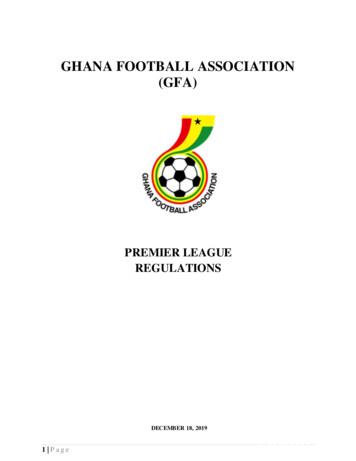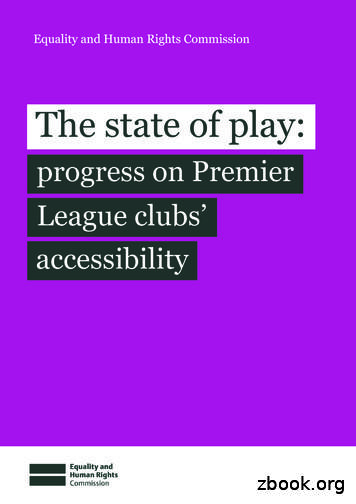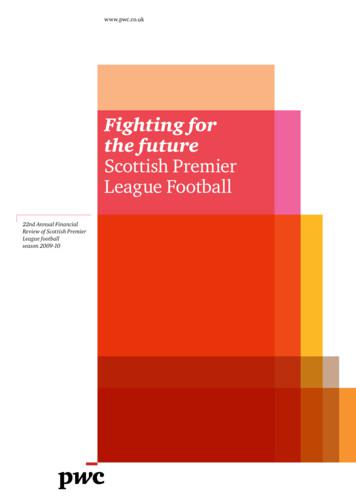Premier League: Economic And Social Impact
Premier LeagueEconomic and socialimpactJanuary 2022
DisclaimerThis report was prepared by Ernst & Young LLP for the PremierLeague, using information provided by the Premier League andits clubs, and other information sourced by EY. EY has beencommissioned by the Premier League to provide an independentassessment of the social and economic contribution of theLeague. The report focuses primarily on the 2019/20 seasonand the evidence of economic and social impact relating to thisseason. The report does not seek to offer opinion or judgementregarding sport-related policy or governance.Ernst & Young LLP does not accept or assume any responsibilityin respect of the Report to any readers of the Report (ThirdParties), other than the Premier League. To the fullest extentpermitted by law, Ernst & Young LLP will accept no liability inrespect of the Report to any Third Parties. Should any ThirdParties choose to rely on the Report, then they do so at theirown risk.Ernst & Young LLP has not been instructed by its client,the Premier League, to respond to queries or requests forinformation from any Third Party and Ernst & Young LLP shallnot respond to such queries or requests for information. FurtherErnst & Young LLP is not instructed by the Premier League toupdate the Report for subsequent events or additional work(if any) performed by Ernst & Young LLP. Accordingly, withoutprejudice to the generality of the foregoing, Ernst & Young LLPaccepts no responsibility to any Third Party to update the Reportfor such matters.All rights reserved.In thisreport1. Executive summary2. Economic impact3. The cycle of growth4. A global league5. Support for the pyramid and wider game6. Support for communities010509151927
1ExecutivesummaryGlobal appealDeveloping homegrown talentThe Premier League and its clubs have made significantinvestments into Academies throughout the Premier Leagueand English Football League (EFL) to develop homegrownplaying talent, while securing some of the world’s top playersthrough transfers.The popularity and commercial success ofPremier League football creates significanteconomic and social impacts, enables awide range of community programmesacross the country and enhances the globalperception of the UK.Since its inception in the 1992/93 season, thePremier League and its clubs (the ‘League’) haveachieved considerable success, establishing astrong global reputation for high-quality andentertaining football, as well as deliveringsubstantial economic and social impacts.Economic impactThe Premier League’s significant contribution was felt acrossEngland in 2019/20, with all nine major regions representedby at least one Premier League club, and 72% of the League’seconomic impact occurring outside of London. The PremierLeague's impact has increased over time, including a 50%increase in tax contributions since 2013/14.In a typical season, Premier League clubs have over halfa million season ticket holders and the highest stadiumoccupancy rate across Europe. Each season, 43 million peoplewatch the Premier League on TV in the UK alone. 7.6bn 3.6bnValue added to UKeconomy in 2019/20(GVA contribution)1Tax contribution in2019/2094,000840%Jobs supported in2019/20Growth in economiccontribution since1998/99 seasonThe Premier League and its clubs’ 1.6 billion investmentin the Elite Player Performance Plan (EPPP) from 2012/13to 2020/21 has benefitted over 90 clubs’ Academies acrossthe football pyramid.3 The strength of the Premier League’sapproach to homegrown player development and acquisitionis evident in the success of Premier League clubs in Europeanclub competition, the representation of Premier Leagueplayers at international level, and the England team’s positiveperformances at recent tournaments, notably EURO 2020.3.2bn 1.4bn2019/20 worldwidecumulative audience2019/20 broadcastexportsGlobal interest in the Premier League continues to grow; in2019/20, the cumulative global viewership (3.2 billion people)was double that of the UEFA Champions League. The League’scommitted global fanbase drives its commercial success,particularly through broadcast and sponsorship income.The Premier League’s 2019/20 international broadcastrevenues totaled 1.4 billion, accounting for the largestshare of the UK’s audiovisual exports and nearly matchingthe combined total achieved by the BBC, ITV, Channel 4,Channel 5, Sky and the independent sector.2This makes Premier League football a core component ofthe media projection of the UK around the world and a majorcontributor to the positive image and soft power of the UK.1 Gross Value Added (GVA) is a measure of economic activity which can be viewed as the incremental contribution to Gross Domestic Product(GDP). It therefore provides a useful measure for understanding the economic contribution made by particular industries, or businesses, such asthe Premier League and its clubs.1 Premier League Economic and social impact 1.6bn50% Premier League investmentbetween 2012/13 and2020/21 to benefit 90 clubs’ Academies via theElite Player PerformancePlan to develophomegrown4 talentIncrease in the numberof minutes played byUnder-23 homegrownplayers in 2019/20compared to the averageacross the previous threeseasons2 UK TV Exports Report — PACT.3 Data provided by the Premier League.4 UEFA rules determine that a player is deemed homegrown if they have been registered at a club for at least three seasons prior to their 21st birthday.Premier League Economic and social impact 2
Adapting to the challenges of COVID-19Support for the football pyramidPremier League support extends across the football pyramidin England and Wales, including all levels of the EFL, NationalLeague System and community football. This support includessolidarity payments distributed to all EFL clubs not in receiptof parachute payments and all 66 National League clubs. Inaddition to this, parachute payments are paid to EFL clubsrecently relegated from the Premier League.In addition to maintaining current levels of financial supportof around 1.5 billion over another three-year broadcastperiod, a further 100 million of funding for the footballpyramid and wider game will be invested across 2021/22to 2024/25. This follows the Government’s approval of anextension to the Premier League’s domestic broadcast rightsdeals on the same terms. This will include additional supportto the National League system; the women’s and girls’ game;community football facilities; EFL clubs; and projects that helpthe wider game. 455m13815% of 2019/20 centralrevenue contributedto support the footballpyramid and localcommunitiesEFL and National Leagueclubs supported by thePremier League viasolidarity and parachutepaymentsThe Premier League is also a funding partner of the FootballFoundation, which has awarded more than 20,400 grantsworth over 770 million to improve grassroots facilitiesacross the country. Local match funding has taken the totalinvestment to more than 1.8 billion since 2000.1505,100 Clubs supportedby Premier Leaguefunding to delivercommunityprojects across thecountryGrants provided bythe Premier Leaguethrough the FootballStadia ImprovementFund, improving groundsthroughout the pyramid1.5m People have benefited from Premier Leaguefunding and support in thousands ofcommunity venues and schools since 2010Impact of the pandemicResponse to the pandemicThe 2019/20 season posed unprecedented challenges forthe Premier League and the whole of football as the worldbattled against COVID-19. After the season was postponedin March 2020, the League worked with the Governmentand other football bodies to enable football to safelyresume behind closed doors through ‘Project Restart’. Thedisruption of fixtures and the absence of fans threatened thesustainability of the League and the impacts it generates.In response to the pandemic, the League made advancedfunds of 125 million available to the football pyramid andunderwrote a financial package to the EFL, including acommitment that no EFL club would go out of business as aresult of the pandemic in the 2020/21 season. In addition,the League committed 35 million for on-the ground deliveryto support the NHS, communities, families and vulnerablegroups, including making facilities available for the nationalvaccination programme.A 250 million COVID-relief package was agreed with the EFLin November 2020, which saw 50 million made availablein grant and monitored grant payments for League One andTwo clubs as well as securing an interest-free loan facilityof up to 200 million that Championship clubs were able toutilise. The Premier League also provided COVID-relief grantsto thousands of EFL, non-league, women’s and grassrootsclubs to help them during the pandemic, as well as preparetheir pitches and stadiums for the return of football and fans,benefitting over 40,000 teams.Supporting communities and wider footballThe Premier League funds 150 Club Community Organisationsacross the Premier League, EFL and National League todeliver programmes in schools and communities. Theprogrammes aim to build stronger communities and promotepositive sporting, health and education outcomes for childrenand young people.This includes funding distributed via the Premier LeagueCharitable Fund (PLCF), which celebrated its 10-yearanniversary in 2020. As one of the biggest sports charitiesin the world, the PLCF invests over 33 million annually tosupport community provision to benefit regions across thecountry where football clubs are based.By March 2021, one year on from the start of the pandemic,the League had funded more than 5,000 activities, whileclubs had made in excess of 100,000 supportive calls tovulnerable fans and delivered over 1.5 million meals to theircommunities.The Premier League is committed to supporting investmentin facilities across the football pyramid and wider game. TheLeague is the sole funder of the Football Stadia ImprovementFund which assists non-league and women’s clubs with thecost of improvements to their grounds. By October 2021, thePremier League had provided more than 5,100 grants, with totalinvestment to date at almost 164 million. 1.3bnEstimated lost broadcastand matchday revenue in2019/20 and 2020/2153 Premier League Economic and social impact18mEstimated reductionin attendance during2019/20 and 2020/211.5m 125mMeals delivered by clubssupported by PremierLeague funding5Advanced funds madeavailable to the footballpyramid in 2019/20As of March 2021.Premier League Economic and social impact 4
Significant economic impact 3.9 billion direct impact of theLeague 1.5 billion indirect impact 2.1 billion induced impact Despite the impact of theCOVID-19 pandemic, the totalGVA contribution is equal to thatin 2016/17 2.2 billion direct impact of theLeague, 1.4 billion of which isaccounted for by players (primarilythrough their income tax andnational insurance contributions) 1.4 billion indirect and inducedimpact through: The League’s supply chain Taxation on employment incomesupported by the League and itssupply chainEconomic activityEconomic impactsPremier League & clubs’ expenditureVisitor expenditure8 1.5bn central domestic 1.8bn supply chain spending 2.9bn wages and salaries7 455m football pyramid and651,000 domestic (away fan)broadcast and commercial 1.4bn central broadcast exports 0.6bn matchday revenue 1.6bn all other club revenuescommunity investmentvisitor trips with total spending9 of 16m528,000 international visitortrips with total spending of 442mDirectIncludes impacts generated within the Premier League and its clubs, including GVA (comprised ofgross operating surplus and staff costs), direct employment and taxes paid and collected.IndirectThe economic activity generated through club and Premier League supply chains and in the widervisitor economy.InducedThe economic activity that is supported by increased spending throughout the economy, facilitatedby direct and indirect employment impacts.Key benefits 7.6bnGVA contributionin 2019/20 3.6bnTax contributionin 2019/2094,000Jobs supportedin 2019/206 EY figures: informed by analysis of Premier League data, clubs’ financial accounts, Office for National Statistics data on the UK economy andother supplementary sources.7 Wages and salaries exclude social security and pension costs.8 VisitBritain estimates that in 2019, there were over 1.5 million visitors to the UK that watched a live football match, spending 1.4 billioncollectively. Whilst our economic analysis only includes visits that are deemed additional — i.e. those that took place for the primary reason ofattending a Premier League football match — VisitBritain’s findings demonstrate the draw of the League and the wider game across the UK foroverseas tourists, and the positive impact this has on the UK economy.9 Visitor expenditure excludes expenditure on tickets.5 Premier League Economic and social impact 12,000 jobs supported directlyby the League’s operations 47,000 jobs supported throughindirect impacts 35,000 through inducedimpactsClubs’ economic contribution hasincreased by more than 800%since 1998/9910 3.5bn 3.3bnPremier League clubs’ revenues have grownsignificantly since 1998/99, delivering a vastlyincreased contribution to the UK economy.Clubs’ gross value added (GVA) contribution(excluding that of the Premier League itself)has grown from 0.7 billion in 1998/99 to 7.2 billion in 2019/20 — a cash terms increaseof 840% (440% in real terms).11There has been significant employment growthdirectly supported by clubs (excluding thePremier League itself); FTE jobs have increasedfrom 11,000 in 1998/99 to over 87,000 in2019/20, a rise of 650%.The total tax contribution underpinned by clubshas increased by 3.1 billion during this period,or 750% in cash terms (390% in real terms).supportedin the UKThe League’s activities supportednearly 94,000 full time equivalent(FTE) jobs across the UK in2019/20:The economic activity stimulated bythe League resulted in an estimated 3.6 billion total contribution to theExchequer in 2019/20 (8% increase on2016/17):Key drivers of the impact of the Premier League and its clubs in 2019/20 are summarised below.Premier League & clubs’ income94,000 jobs 2.3bn93k87k71k 1.0bn 0.4bn36k12kTax2019/20Premier League football drives economic activity across the UK. The income generated enables significant expenditure acrosssupply chains, supports thousands of jobs, and creates sizeable tax revenues. The popularity of Premier League football has alsodeveloped a thriving visitor economy. in taxcontributions2013/14The Premier League economy6The League’s contribution to UKGross Domestic Product (GDP) isapproximated through the GrossValue Added (GVA) it generates. In2019/20, the League generated 7.6 billion in GVA: 3.6 billion2007/08The Premier League and its clubs drivesignificant economic activity nationallyand regionally through their commercialrelationships and supply chains, generatingtax revenue, supporting tourism andcreating employment opportunities.in UK GDPcontribution2016/17 7.6 billion1998/992EconomicimpactEmploymentSource: EY analysis10 Impacts presented are specific to clubs; they exclude that of the Premier League itself as an organisation. The 87,000 FTE jobs impact can beadded to the Premier League’s impact of 7,000 to arrive at the total figure of 94,000 referenced elsewhere in this report.11 Cash terms figures have not been adjusted for inflation, whilst real terms figures are. Real terms figures are therefore in constant prices.Premier League Economic and social impact 6
The economic impact of Premier League football is felt across the nationThe economic impact would have been up to 15% higher had 2019/20 been a ‘typical’ seasonThe economic activity supported by the League is distributedacross much of England and Wales, due to the geographicalspread of Premier League clubs. While the geography of thePremier League’s economic footprint fluctuates each season,The 2019/20 season was significantlydisrupted by the COVID-19 pandemic, whichbrought significant implications for both therevenues and costs of the Premier Leagueand its clubs.2019/20 saw all major regions of England represented by atleast one club. Overall, 72% of the League’s economic footprintwas located outside of London.In the absence of this disruption, the economicimpact of the League would have beensignificantly higher. Overall, it is estimated thatif the 2019/20 season had gone ahead as atypical season, the impacts would have been:Geographical spread ofPremier League clubs in the2019/20 season(Logos in colour) and otherclubs that have competedbetween 2012/13 and2021/22 (monochrome) 3.9 billion in tax revenues ( 0.3 billionhigher) 8.7 billion in GVA ( 1.1 billion higher) 99,000 FTE jobs (5,000 higher) 6.1 billion in revenue ( 1.0 billion higher)West Ham United: pillar of the local economyAn EY report in 2019 found that West Ham United makes asubstantial contribution to its local economy of London andEssex. Through its role as a major employer, spending withlocal businesses in its supply chain, and the thousands ofvisitors it attracts over the course of the season, the clubsupports wide-ranging economic impacts.-000019120000191288-01In 2018/19:Substantial local economic contributions The club contributed a total of 300 million in GrossValue Added (GVA) to the regional economy both directlyand indirectly through its supply chain, job opportunitiesand the visitor economy. This supports 3,300 local andregional jobs. Almost half (45%) of all staff are residents of boroughslocal to the club. Almost half of total supply chain spending is sourced fromlocal suppliers, equating to 15 million. All club and stadium staff, and those of suppliers, are paidat least the London Living Wage. Over 50,000 away Premier League supporters visit theLondon Stadium, bringing additional spending into thelocal economy.The largest economic impacts in 2019/20 were in London and theNorth West, with clubs driving impacts in each of these regions of 2.1 billion in GVA and 21,000 FTE jobs.GVA contribution of the Premier League, selected regions, billions (percentage share of regional GVA circled), 2019/20GVA, bn0.01.52.00.5%North West1.2%South Coast Premier League Economic and social impact1.0LondonMidlands70.5Greater Manchester: 1.1bn0.2%0.5% The club invested 5 million into the Chadwell Heath andRush Green training facilities, and London Stadium in2018/19. 300m3,300Regional GVAcontributionRegional jobssupportedThe club launched their Players’ Project in 2018, withplayers from their men’s, women’s and Academy teamsgiving more than 300 hours of community time in theprogramme’s first year.Premier League Economic and social impact 8
3The cycle ofgrowthThe Premier League has a profoundinfluence on all aspects of the Englishgame, from the quality of elite competition,to grassroots participation and investmentin communities.COVID-19 disruptionThe pandemic caused significant disruption to the PremierLeague and the cycle of growth: 472 matches in 2019/20 and 2020/21 were playedbehind closed doors or with limited capacity, resulting inan estimated 18 million reduction in attendances. Fixture and broadcast disruption: delayed end to2019/20 and start to 2020/21; 1.3 billion lost inmatchday and broadcast revenues. Challenges in the community: Clubs adapted to delivervital services to help address new and acute communityneeds presented by the pandemic.for the completion of the 2019/20 season and for the2020/21 season to be played out in full.Maintaining the connection with fansClubs maintained regular dialogue with fans and providedsignificant support during the temporary suspension offootball and while matches were played behind closeddoors. For example: Brighton made use of Fans Forums, with several virtualQ&A sessions with senior staff members, covering issuesthat impacted supporters, including plans for fans’return and season ticket renewals. Liverpool Disabled Supporters Association praisedthe club for maintaining contact with fans throughoutlockdown periods, maintaining engagement to supportfans’ mental health. Southampton: Saints Foundation delivered prescriptionsto homes throughout the pandemic, and launched ahotline for vulnerable local residents.Safe resumption of football — Project Restart’s successThe cycle of growthFootball occupies a prominent position in the UK, withmillions of children and adults from all backgrounds playingor watching the game on a regular basis. Media coverage isa near-constant reminder of the cultural significance of thesport, both reflecting and contributing to the power of footballto engage with a diverse range of people and communitiesacross society.All 92 football clubs throughout thePremier League and EFL supported withAcademy funding and/or funding to deliverCommunity Projects9,000 grass pitches have been improvedat grassroots sports facilities throughthe Football Foundation since 2000. ThePremier League has contributed 384m tothe charity, which has provided more than20,400 facility grants.Investing in high-quality football is at the heart of the PremierLeague’s success. This is a key driver of fan engagement,and thereby supports commercial performance. Equitabledistribution of this success enables the Premier League andits clubs to reinvest in the future of the game, deliveringcompetitive and entertaining football for fans over a prolongedperiod of time.Delivering a vibrant andengaging competition thatresonates with ementInvesting in stadia, facilities andfuture footballing talent1.6:1 ratio of highest to lowest centralrevenue distributions, the lowest of topfive European leagues 455m: 15% of central revenuescontributed to support clubs throughoutthe football pyramid and local communitiesDistributeequitablySupporting widerfootball, communitiesand societyIn conjunction with football stakeholders and theGovernment, the Premier League successfully undertookProject Restart to deliver the safe return of football inJune 2020, following its suspension in March. This allowedImpact of returning fansAfter matches were played behind closed doors at theend of the 2019/20 season and for the majority of the2020/21 season, capacity crowds were welcomed backat the start of 2021/22.117 players from 2021/22Premier League clubs at EURO2020Fans’ wellbeing: matchdays provide a focal point forsocialising and regular entertainment that can boostwellbeing.7 of 12 UCL/UEL13 finalistsfrom 2018/19 to 2021/22were Premier League clubsMatch atmosphere: the atmosphere generated byfans within the stadium enhances the broadcast viewerexperience, contributing to the attractiveness ofPremier League football to broadcasters.Converting interest intocommercial success andsustainable growth 1.6bn total club commercialrevenues3.2bn cumulative globalviewership““Richard Beech, Leeds United fanRichard Masters,Premier LeagueChief ExecutiveMe and my wife have beengoing together for about25 years and now both mychildren are season-ticketholders. For us all to be partof an atmosphere again wasfantastic.Fans have beenhugely missed andthe Premier Leaguehas not been the samewithout them.Commercial impacts: matchday revenues are animportant contributor to clubs’ finances in the PremierLeague and across the football pyramid. A return topre-pandemic attendances would increase matchdayrevenues by approximately 1.8 million per match forthe average Premier League fixture, or 675 millionacross the 2021/22 season.Economic benefits: increased levels of matchdayrelated activity associated with a return to pre-pandemicattendances would be expected to drive an increasein GVA impacts of 4.1 million per match; equivalentto nearly 1.6 billion in GVA over the course of the2021/22 season.12 Figures quoted within this diagram relate to 2019/20 unless otherwise stated.13 UEFA Champions League/UEFA Europa League.9 Premier League Economic and social impactPremier League Economic and social impact 10
High-quality footballThe competitiveness of the Premier Leaguedrives the quality of football on showThe Premier League comprises a mix of internationalstars and elite homegrown talent and this quality drivesthe competitiveness and entertainment of the League. In2019/20, 48% of total Premier League minutes were recordedby homegrown players. 2019/20 was a breakthroughseason in particular for young homegrown players with 62homegrown players making their debut in the Premier League,and 16% of all minutes coming from U23 homegrown players.This was more than a 50% increase on the average across theprevious three seasons.14There is variety in both participants and winners of thePremier League, with Brentford becoming the 50th clubto compete in the division in 2021/22, after Liverpool hadbecome the seventh Premier League title winners in 2019/20.50Different clubs havecompeted in thePremier League since1992/937Premier League-winningclubs, including a newChampion in 2019/20(Liverpool)Premier League clubs enjoy European successThe quality of Premier League football is illustrated by itsclubs’ recent dominance in UEFA’s two European internationalclub competitions, the Champions League and the EuropaLeague, with Premier League clubs making up seven of the12 finalists between 2018/19 and 2020/21.Premier League players strongly represented onthe international stageThe high standard of players throughout the Premier Leagueis a key differentiator of its quality relative to other elitecompetitions.Domestic football league systems with the most players atEURO 2020Top division160140120Lower 23929SpainFranceSource: Twenty First Group14 Data provided by the Premier League.11 Premier League Economic and social impactPremier League Economic and social impact 12
Fan engagementThe quality of Premier League football is a key driver of thewidespread interest in the League, both domestically andaround the world.Stadium utilisation was at record levels in2019/20In 2019/20, Premier League grounds operated at close tofull capacity prior to the temporary suspension of the season.The average price paid for a Premier League ticket during2019/20 was 32, with most fans paying 30 or less permatch. Of the more than 500,000 season-ticket holdersacross the Premier League, there were almost 65,000 juniors,who paid 7 per match on average.97.8%Stadium utilisationprior to COVID-19disruption; a newLeague record39,537Average matchattendance prior toCOVID-19 disruption; anew League recordThe Premier League leads the world in globalbroadcast viewershipThe Premier League continues to be the most-watched footballleague in the world. Its cumulative global audience in 2019/20was 3.2 billion, nearly double that of the next most watchedleague in Europe (the German Bundesliga) and the UEFAChampions League.Cumulative global audience (millions)3,160Distribute equitablyMost equitable distribution of revenue to clubsIn 2018/19, central revenues15 were distributed moreequitably among Premier League clubs compared to theother top five European leagues, helping to maintaincompetitiveness of the competition. For example, the bestremunerated club received 1.6x as much revenue as the leastremunerated club; this ratio is less than half of that in La Liga.Improve and invest1,6251,600A consistent commitment to supporting thefootball pyramid and local aChampionsLeagueLa LigaSerie ALigue 1Source: NielsenStrong pre-pandemic growth across revenuechannelsRatio of central income for top vs. bottom club (2018/19)The Premier League shares resulting success with EFL,non-league, women’s and grassroots clubs, as well aslocal communities. 15% of central League revenues weredistributed to the football pyramid and communities in2019/20, equating to 455 million.Sections 5 and 6 of this report provide further detail ofthe support provided to the football pyramid and localcommunities by the Premier League.3.6x3.7x3.8xSerie ABundesligaLa Liga3.1x1.6xPremierLeagueLigue 1Source: Club accounts and other official sources3,000 Clubs playing across 109 leagues awarded football groundimprovement grants from the Premier League through theFootball Stadia Improvement Fund since 20001.5mUnique participants engaged in Premier LeagueCharitable Fund programmes by its 10-yearanniversary in 2020/21The Premier League’s widespread appeal has driven financialgrowth over time. The League’s broadcast, matchday andcommercial revenues all increased over the five years to2018/19. COVID-19 impacted this significantly, but overallrevenues were still just below 2016/17 season levels.Total Premier League club revenues 2013/14-2019/20( 16/172015/162014/152013/143,000Source: Premier League15 Revenue generated by the league body and distributed to clubs.13 Premier League Economic and social impactPremier League Economic and social impact 14
4A globalleagueEvents overseas provide opportunities to engage with international fansThe Premier League’s global popularityis driven by high-quality football andinternational stars. This supports theLeague’s international broadcast appealand makes Premier League football avaluable asset to the brand of the UK.Pre-season enables clubs to tour other countries, to engage with overseas fans in person. In 2019/20, clubs visited 16overseas markets during pre-season tours. The Premier League has also hosted a number of fan events, including pre-seasontournaments, trophy tours and fan parks, bringing the Premier League experience to fans around the world.Premier LeagueAsia TrophyWolverhampton Wandererscelebrating winning the2019 Asia Trophy inShanghaiBetween 2003 and 2019, fans in Asia were giventhe opportunity to watch live Premier Leaguefootball as teams travelled to take part in thePremier League Asia Trophy, a biennial preseason tournament. The ninth instalment tookplace in China in 2019, with the tournament
Premier League and its clubs (the 'League') have achieved considerable success, establishing a strong global reputation for high-quality and entertaining football, as well as delivering substantial economic and social impacts. Economic impact The Premier League's significant contribution was felt across
THE PREMIER LEAGUE Premier League Fixtures 2016/17 Release Date June 15th 2016 These fixtures are now finalised following consultation with the 2016/2017 Premier League members and Football League counterparts. This document is to be kept strictly confidential by all Premier League Members for the 2016/2017 Football Season, as per Premier .
Association Premier League Regulations" and the provisions shall be referred to as Articles, Clauses and Sub-Clauses. 2. Control of the Premier League The control and management of the Premier League in the country shall be vested in the GFA. 3. Laws of the Game Each Member of FIFA shall play Association Football in compliance with the Laws of
In September 2015, all Premier League clubs committed to ensuring that by August 2017 they would meet the standards set out in the ASG. This 'Premier League Pledge' was voluntary, but clubs all have legal obligations under the Act. In December 2016, the Commission wrote to all 20 Premier League clubs asking for
Club International: Champions League, Champions League Qualification, Europa League (from round 16), Europa League Qualification, UEFA Super Cup, AFC Champions League, Copa Libertadores, Copa Sudamericana Live Stats leagues The details covered vary from league to league. We have list
of Scottish Premier League (SPL) football. compared to the previous season's run in the Champions League group stage. Making reasonable adjustments for these items shows that the league generated an underlying loss of c 16m. Adjustments ( m) Headline profit 1 Less: exceptional profit adjustment (7) Less: Champions League profit adjustment (10)
the Premier League provides contributions to support the wider football pyramid and various charitable causes. This was about 200m in 2017/18, equivalent to almost 7% of the League's total central revenues for the year. Meanwhile, 211m exited the game in payments by Premier League clubs to agents. As the Premier League and its clubs have
Perhaps Panini America's best brand and the world's best top- ight soccer league come together once again in 2020-21 Prizm Premier League Soccer. With all of the best players from all of the 2020-21 Premier League clubs showcased on Panini's brilliant opti-chrome technology, these cards are not to be missed for the 2020-21 season!
Python is a programming language that is easy to learn, which is why many novice coders choose it as their first language. Because it was built as a general-purpose language, it is not limited to just one type of development - you can use it for anything from analyzing data, to creating games. Python has also become incredibly popular in the scientific community because scientists use it to .























